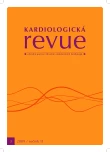Development of a prognostic score in patients with chronic cardiorenal syndrome
Authors:
F. Málek 1; M. Havrda 2; L. Dobrovodská 1; Z. Frühaufová 2; M. Lapšová 2
Authors‘ workplace:
3. LF UK Praha
1; Nefrologické oddělení, I. interní klinika FN KV a 3. LF UK Praha
2
Published in:
Kardiol Rev Int Med 2009, 11(3): 108-110
Category:
Nontraditional risk factors cardiovascular disease
Overview
A prognostic score was established from seven independent prognostic parameters pertinent to patients with chronic heart failure (CHF) and impaired renal function. These parameters were: estimated glomerular filtration rate (eGFR), left ventricular ejection fraction (LV EF), left atrial index (LAi), estimated pulmonary artery pressure (ePAP), haemoglobin level (Hb), albumin concentration (alb) and furosemide daily dose (FSM). Each parameter was evaluated on a 4-point numerical scale and the overall score was calculated as a sum of all parameters. The aim of the study was to evaluate changes to the prognostic risk score over time in 20 patients with chronic cardiorenal syndrome (CRS), LV EF < 45%, eGFR < 1.0 ml/sec/1.73 sqm. Retrospective analysis of the prognostic parameters at the first (V1), follow‑up (V2) and the most recent (V3) clinic visits was performed. The risk score was calculated and the differences assessed with the statistical t‑test. The mean follow‑up between V1 and V3 was 474 ± 169 days. There was a significant risk score change between V1 and V2 (from 18.25 to 16.55, p = 0.007). Among the individual parameters, there was a significant change in ePAP only (from 49 to 37.5 mmHg, p < 0.01). The score and ePAP changed significantly between V1 and V3 too (from 18.25 to 15.25, p < 0.001 and from 49 to 31.25 mmHg, p < 0.001, respectively). Neither mean LV EF (36.7% to 45.25%), nor eGFR (0.48 to 0.51 ml/sec, p = 0.076 and p = 0.61, respectively) changed significantly between V1 and V3. The prognostic score in patients with chronic CRS significantly decreased during the short‑term follow‑up. Preliminary results should be confirmed in a larger patient population during a long‑term follow‑up.
Keywords:
cardiorenal syndrome – heart failure – renal insufficiency – prognostic parameters
Sources
1. McAlister FA, Ezekowitz J, Tonelli M et al. Renal insufficiency and heart failure: prognostic and therapeutic implications from a prospective cohort study. Circulation 2004; 109 : 1004–1009.
2. Dzau VJ. Renal and circulatory mechanisms in congestive heart failure. Kidney Int 1987; 31 : 1402–1415.
3. Hillege HL, van Gilst WH, van Veldhuisen DJ et al. Accelerated decline and prognostic impact of renal function after myocardial infarction and the benefits of ACE inhibition: the CATS randomized trial. Eur Heart J 2003; 24 : 412–420.
4. Hillege HL, Girbes AR, de Kam PJ et al. Renal function, neurohormonal activation, and survival in patients with chronic heart failure. Circulation 2000; 102 : 203–210.
5. Cohen N, Gorelik O, Almoznino–Sarafian D et al. Renal dysfunction in congestive heart failure, pathophysiological and prognostic significance. Clin Nephrol 2004; 61 : 177–184.
6. Shlipak MG, Massie BM. The clinical challenge of cardiorenal syndrom. Circulation 2004; 110 : 1514–1517.
7. Bongartz LG, Cramer MJ, Doevendans PA et al. The severe cardiorenal syndrome: “Guyton revisited”. Eur Heart J 2005; 26 : 11–17.
8. Málek F, Havrda M, Frühaufová Z et al. Multidisciplinární přístup v péči o nemocné s kardiorenálním syndromem – první zkušenosti. Cor Vasa 2006; 48: Kardio K 185.
9. Cockcroft DW, Gault MH. Prediction of creatitine clearance from serum creatinine. Nephron 1976; 16 : 31–41.
10. National Kidney Foundation. K/DOQI clinical practice guidelines for chronic kidney disease: Evaluation, classification, and stratification. Am J Kidney Dis 2002; 39: S1–S266.
11. Špinar J, Hradec J, Meluzín J et al. Doporučení pro diagnostiku a léčbu chronického srdečního selhání ČKS 2006. Cor Vasa 2007; 49 : 75–104.
12. Cohn JN, Johnson GR, Shabetai R et al. Ejection Fraction, Peak Excercise Oxygen Consumption, Cardiothoracic Ratio, Ventricular Arrhythmias, and Plasma Norepinephrine as Determinants of Prognosis in Heart Failure. Circulation 1993; 87: VI5–VI16.
13. Cowie MR, Wood DA, Coats AJS et al. Survival of patients with a new diagnosis of heart failure: a population based study. Heart 2000; 83 : 505–510.
14. Kizer JR, Bella JN, Palmieri V et al. Left atrial diameter as an independent predictor of first clinical cardiovascular events in middle–aged and elderly adults: the Strong Heart Study (SHS). Am Heart J 2006; 151 : 412–418.
15. Carr SJ, Bavanandan S, Fentum B et al. Prognostic potential of brain natriuretic peptide (BNP) in predialysis chronic kidney disease. Clin Sci 2005; 109 : 75–82.
16. Groenning BA, Raymond I, Hildebrandt PR et al. Diagnostic and prognostic evaluation of left ventricular systolic heart failure by plasma N‑terminal pro‑brain natriuretic peptide concentration in a large sample of the general population. Heart 2004; 90 : 297–303.
17. Herget-Rosenthal S, Marggraf G, Husing J et al. Early detection of acute renal failure by serum cystatin C. Kidney Int 2004; 66 : 1115–1122.
Labels
Paediatric cardiology Internal medicine Cardiac surgery CardiologyArticle was published in
Cardiology Review

2009 Issue 3
Most read in this issue
- ECG monitoring with Holter monitor
- Current opinions about the role of mild hyperhomocysteinaemia as a risk factor of cardiovascular diseases
- Uric acid and cardiorenal risk
- HRT and cardi ovascular risk
